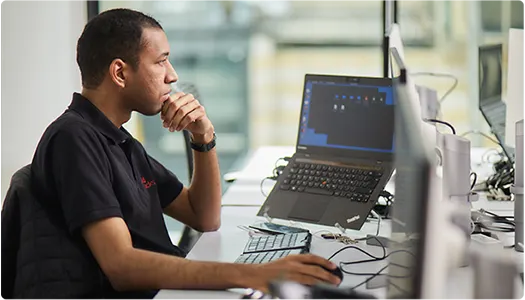Fluid Attacks' Secure Code Review solution provides you with a comprehensive review of your software's source code. Specifically, this solution is intended to identify whether your lines of code are following required coding standards and whether there are security flaws or vulnerabilities that need to be remediated promptly to prevent any cyberattack. We employ a diverse set of security testing techniques, including SAST and SCA, always using a combination of automatic and manual processes to achieve these objectives. Through our comprehensive secure code review methodology, we minimize false negatives and deliver reports with very low rates of false positives.
Contrary to common practice, the Secure Code Review solution is applied to your applications' code from the early stages of the software development lifecycle (SDLC) and at a continuous pace. This means our solution offers an advantage over traditional secure code review services, prompting you to reduce security risks before the software is released, thus avoiding future costs of remediation.
Benefits of Secure Code Review
Updated source code security
Early and constant secure source code review can allow the system, in general, to maintain updated and secure components, that is, to follow all kinds of trends in cybersecurity in favor of the integrity and confidentiality of the information.
Accurate security assessments
Our Secure Code Review solution offers a combination of the advantages of secure code review tools and manual code review. This approach allows for an accurate examination of your software's source code structure and functionality in order to detect every type of error and weakness, so you can then diligently remedy them to ensure code quality and security.
Full tracking of vulnerabilities in code
Our platform allows you to access general and specific data for each finding in your code reported by our expert security analysts. Furthermore, it enables your team to follow the entire vulnerability remediation process with detailed, up-to-date information.
Secure coding compliance assessments
We check that you comply with best practices laid out in secure coding guides by reliable sources such as the OWASP.
Do you want to learn more about Secure Code Review?
We invite you to read our blog posts related to this solution.
Secure Code Review FAQs
What is secure code review?
The meticulous process of examining code for security abnormalities that could give rise to incidents is called secure code review. The primary goal of a secure code review is to find flaws, hopefully in the early stages of the SDLC, before they can be exploited by malicious actors. It proves to be a proactive stance in software development, ensuring it meets coding best practices and security standards. It also helps companies save time and money and preserve their good name. Code review can be carried out manually, using automated tools or through a combination of both methods.
How to do a secure code review?
Your team should be reviewing source code from the very moment they start writing it. The main goal is to reduce the risk of successful cyberattacks due to code vulnerabilities that emerge during the development cycle. The source code review process should be constant and involve a combination of scanning by automated tool and manual assessments so that every vulnerability is found and properly confirmed. Automation helps find known and simple vulnerabilities, saving time for security analysts, while the manual technique helps examine the code in context and intention to identify unknown and complex vulnerabilities and validate the tool scan results.
Which secure code review tools are commonly used?
Code review works best with a combination of automatic tools and manual processes. It can be performed automatically using tools ideal for identifying known weaknesses or vulnerabilities, like those reported in OWASP or CVE lists. Tools commonly used for secure code review include those that can perform static application security testing (SAST) and software composition analysis (SCA). Any comprehensive secure code review procedure should include manual code review by security experts. Even though automated technologies are capable of identifying a large variety of vulnerabilities, they cannot take the place of reviewers' expertise and knowledge.
What security requirements do you check when doing source code review?
At Fluid Attacks, we compile our own list of requirements —which are written as specific objectives— upon revision of several international standards related to information security. Among these standards are the OWASP Secure Coding Practices Reference Guide (OWASP SCP), the Health Insurance Portability and Accountability Act (HIPAA) and the Payment Card Industry Data Security Standard (PCI DSS). Some of the requirements we check are: removing commented-out code, excluding unverifiable files (e.g., binaries), verifying that the versions of third-party components in use are stable, tested and up to date, and many others.
Why is secure code review important?
The most effective development teams make use of this practice when creating software because they know its advantages. Secure code review helps prevent security breaches by identifying vulnerabilities early and throughout the SDLC, which in turn helps reduce the time developers spend addressing issues and boosts production. Additionally, it provides an opportunity for team members to share knowledge, collaborate and split the security responsibilities. Constant source code review enhances a company’s security strategy.
Get started with Fluid Attacks' Secure Code Review solution right now
Join the organizations that are preventing cyberattacks by letting us look at their source code and guide them through the remediation of vulnerabilities. Don't miss out on the benefits, and ask us about our 21-day free trial for a taste of our Secure Code Review solution.









